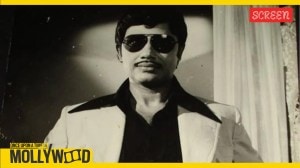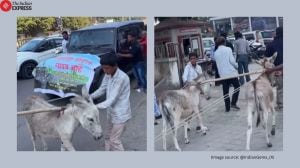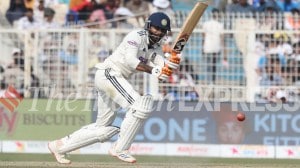At Ground Zero, the chorus is: stop using us
It’s raining in Ayodhya. Grey clouds loom over the disputed Babri Masjid site, guarded by sullen PAC, some of them shirtless in the hea...

It’s raining in Ayodhya. Grey clouds loom over the disputed Babri Masjid site, guarded by sullen PAC, some of them shirtless in the heat. Saffron-clad sadhus in dark glasses and wooden khadaus rattle by on their Bajaj scooters.
Ayodhya’s future hangs in the balance; tomorrow, the Muslim Personal Law Board will decide whether or not to accept the Shankaracharya’s peace formula. But through this area, in Ayodhya and Faizabad, there’s an overwhelming feeling of cynicism and deja vu.
 In Shringaar haat, Ayodhya’s main market, business owners and shopkeepers gaze wearily at the drizzle and say they are indifferent to the AIMPLB’s meeting — in fact, few even know it’s scheduled. The vegetable sellers wheel their reras, software engineers hammer away at their keyboards, tailors cut cloth, trainee sadhus cycle off to class. Says property broker Mohammad Naseem: ‘‘Will this meeting end our suffering? Will it bring back those burnt in their beds in 1992? Will it free those innocents arrested under POTA and placed in the SIMI category? The Muslim lives in a shell. The law and the Constitution, the very things he depends on, have turned against him. And you ask about some Law Board meeting?’’
In Shringaar haat, Ayodhya’s main market, business owners and shopkeepers gaze wearily at the drizzle and say they are indifferent to the AIMPLB’s meeting — in fact, few even know it’s scheduled. The vegetable sellers wheel their reras, software engineers hammer away at their keyboards, tailors cut cloth, trainee sadhus cycle off to class. Says property broker Mohammad Naseem: ‘‘Will this meeting end our suffering? Will it bring back those burnt in their beds in 1992? Will it free those innocents arrested under POTA and placed in the SIMI category? The Muslim lives in a shell. The law and the Constitution, the very things he depends on, have turned against him. And you ask about some Law Board meeting?’’Khaliq Ahmad Khan, artist and art gallery owner in neighbouring Faizabad, sings an old Mukesh song. ‘‘Bahut diya hai dene wale ne tujhko, aanchal hi na samay’’. India has given Muslims so much, he grins sarcastically, our aanchals have no more place.
The Shankaracharya’s formula, he says, is not acceptable. ‘‘The Law Board should not look as if it is stalling or against a resolution, or rejecting the Shankaracharya. Instead, it should ask to talk to other religious leaders, including the Shankaracharya of Dwarka and the priests of Lucknow and Ayodhya.’’
The Sultanate of Avadh, of which Faizabad was entrepot, capital and bustling trading post, has petered out into meagre empty waiting. Waiting for meetings, formulas, resolutions, oppositions, meetings again.
‘‘This was a business centre once, the Manhattan of the 18th century’’, says SM Abbas who runs a software company. ‘‘Now business is finished, the money goes to Allahabad and Varanasi. If a Muslim does good business, the government taxes him to death. If he defaults they rip up the doors and windows and take them away.’’
Among the Muslims, some of the cynicism is directed at the Law Board members. ‘‘Who are these people anyway’’, asks local advocate Abdul Mabood Rizvi, ‘‘They are all out to make money. Most of them are careerites, except a few like Kalbe Sadiq. The rest are pretenders.’’
Otherwise, there’s a sharp polarisation of feelings. Muslims insist on waiting for the court verdict, Hindus want the mandir. ‘‘The only way forward is to make it an orphanage’’, suggests Zahir Ahmad Kidwai from Barabanki, but his is a rare placatory voice.
‘‘If a masjid is not allowed on the site, it means destroying all the other 50 masjids in Ayodhya’’, says Khaliq Ahmad Khan.
‘‘The saints will stage a bloody revolution’’, threatens Vishambhar Das Shastri, dressed in flaming orange with sindoor all over his black curly hair. ‘‘We will kill, we will burn, we will die, we will commit atmahatya if a masjid is built. If a mandir is built, then the BJP will get absolute majority.’’
In a corner outside the disputed site sits a paanwallah who is an unemployed journalist. ‘‘No matter what the meetings says, this is the place of Ram’’, says Ajay Nag, ‘‘no masjid can be allowed.’’
The Shankaracharya himself becomes the topic of discussion but here again the cynicism comes out strong. They’ve seen too many archaeologists, politicians and experts to trust another peacebroker.
‘‘We don’t trust this Shankaracharya’’, says Mohammad Younus Siddiqi, chairman of the Babri Masjid Action Committee. ‘‘How can we trust anyone who said Narasimha Rao did a great act of punya when he allowed the masjid to fall? But we will abide by the Board’s decision.’’
Groups of saffron-clad sadhus and Muslim youth stroll by. There is friendly talk between them yet sadness and resignation at the fate of their city. ‘‘All show of friendship is a charade’’, says Mohammad Naseem. ‘‘Underneath, each of us is suspicious and angry. The city has been ruined by the PAC and press and left a legacy of hate and violence.’’
‘‘Ayodhya is an industry’’, says Madan Lal, a halwai in Shringaar market. ‘‘Inka roti ka sawal hai. An industry for politicians, for press, for VHP and for Muslim leaders. The only thing is it is not an industry for the people of Ayodhya or Faizabad.’’ The rain has stopped in Ayodhya. But the clouds remain.





- 01
- 02


























